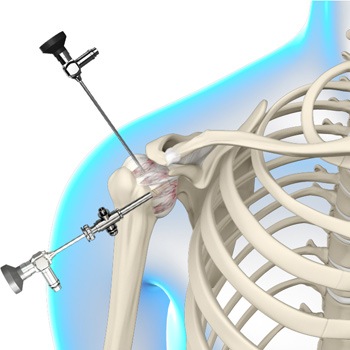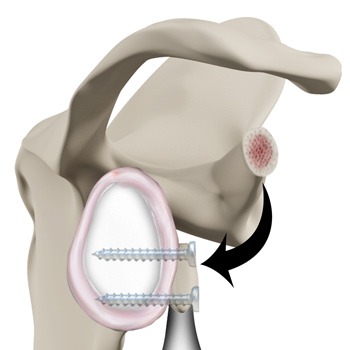- Anatomy
- Conditions
- Procedures
Shoulder Replacement
Shoulder replacement is a surgical procedure in which the damaged or worn out articulating surfaces of the shoulder joint (surfaces of the humeral head and glenoid socket) are removed and replaced with artificial prostheses made of metal or plastic.
Shoulder Arthroscopy
Arthroscopy is a minimally invasive diagnostic and surgical procedure performed for joint problems. Shoulder arthroscopy is performed using a pencil-sized instrument called an arthroscope. The arthroscope consists of a light system and camera that projects images of the surgical site onto a computer screen for your doctor to clearly view. Arthroscopy is used to treat disease conditions and injuries involving the bones, cartilage, tendons, ligaments, and muscles of the shoulder joint.
Rotator Cuff Repair
Rotator cuff repair is a surgery to repair an injured or torn rotator cuff. It is usually performed arthroscopically on an outpatient basis. An arthroscope, a small, fiber-optic instrument consisting of a lens, light source, and video camera. The camera projects images of the inside of the joint onto a large monitor, allowing your doctor to look for any damage, assess the type of injury and repair it. Large rotator cuff tears may require open surgery.
SLAP Repair
A SLAP repair is an arthroscopic shoulder procedure to treat a specific type of injury to the labrum called a SLAP tear.
Shoulder Stabilization
Shoulder stabilization surgery is performed to improve stability and function to the shoulder joint and prevent recurrent dislocations. It can be performed arthroscopically, depending on your particular condition, with much smaller incisions. Arthroscopic stabilization is a surgical procedure to treat chronic instability of the shoulder joint.
Shoulder Labrum Reconstruction
The shoulder joint is a ball and socket joint. A ball at the top of the upper arm bone (the humerus) fits neatly into a socket, called the glenoid, which is part of the shoulder blade (scapula). The labrum is a ring of fibrous cartilage surrounding the glenoid, which helps in stabilizing the shoulder joint. The biceps tendon is attached inside the shoulder joint at the superior labrum of the joint. The biceps tendon is a long cord-like structure that attaches the biceps muscle to the shoulder and helps to stabilize the joint.
Same Day Shoulder Surgery
Same-day shoulder surgery is a procedure that does not require an overnight stay in the hospital. This is made possible with recent advances in technology that has allowed this procedure to be performed in a minimally invasive manner on an outpatient basis allowing patients to go home the same day of the surgery. The procedure involves repairing a diseased, damaged, or degenerated shoulder joint arthroscopically.
Arthroscopic Frozen Shoulder Release
An arthroscopic frozen shoulder release is a minimally-invasive shoulder surgery performed to relieve pain and restore normal function using a special instrument called an “arthroscope”.
Latarjet Procedure
The shoulder joint provides a wide range of movement to the upper extremity, but overuse or trauma can cause instability to the joint. The Latarjet procedure is a surgical procedure performed to treat shoulder instability by relocating a piece of bone with an attached tendon to the shoulder joint.
Revision Rotator Cuff Surgery
Revision rotator cuff surgery is a procedure done to repair a re-tear in the rotator cuff after a failed initial rotator cuff surgery. The revision surgery is generally more complex, as it attempts to repair a rotator cuff that has been torn multiple times.
Complex Fracture Repair of the Shoulder
Complex fracture repair of the shoulder is a surgical procedure that involves the use of surgical plates and screws to repair a severe fracture of the bones that form the shoulder joint. Complex shoulder fractures are usually accompanied by ligament and tendon injuries that may also need to be repaired.
Non-surgical Shoulder Treatments
Rest plays an important role in restoring shoulder health and shouldn’t be taken lightly. Usually, a sling is worn to keep the arm immobile and stable. You should try to avoid using the injured arm as straining the injured shoulder may lead to future complications. Physical rest can also help keep inflammation under control.





















